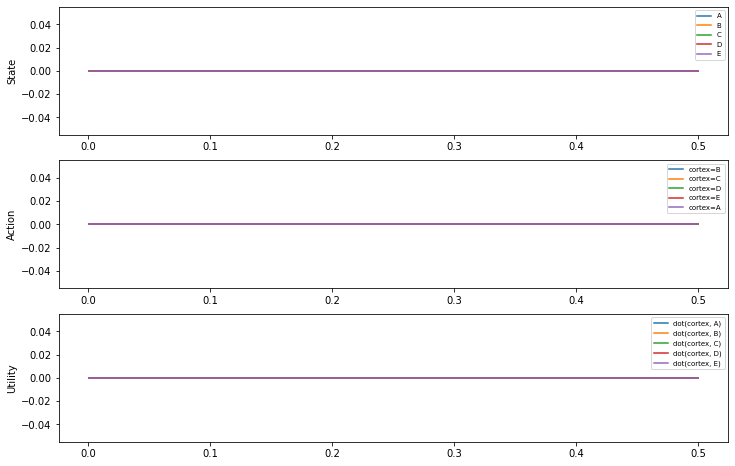Ablating neurons in a SPA model¶
The model used here is a SPA model that goes through a set sequence of semantic pointers, as shown in this NengoSPA example.
This is primarily a demonstration of how to apply the ablate_ensemble function to all the ensembles in a network or SPA module. If you haven’t gone through the ablate_ensemble example in this directory, go through that example first.
[1]:
%matplotlib inline
import numpy as np
import matplotlib.pyplot as plt
import nengo
from nengo import spa
[2]:
dimensions = 16
def start(t):
if t < 0.05:
return "A"
else:
return "0"
with spa.SPA() as model:
model.cortex = spa.Buffer(dimensions=dimensions)
actions = spa.Actions(
"dot(cortex, A) --> cortex = B",
"dot(cortex, B) --> cortex = C",
"dot(cortex, C) --> cortex = D",
"dot(cortex, D) --> cortex = E",
"dot(cortex, E) --> cortex = A",
)
model.bg = spa.BasalGanglia(actions=actions)
model.thal = spa.Thalamus(model.bg)
model.input = spa.Input(cortex=start)
cortex = nengo.Probe(model.cortex.state.output, synapse=0.01)
actions = nengo.Probe(model.thal.actions.output, synapse=0.01)
utility = nengo.Probe(model.bg.input, synapse=0.01)
[3]:
with nengo.Simulator(model) as sim:
sim.run(0.5)
/home/tbekolay/Code/nengo/nengo/builder/builder.py:234: UserWarning: Object <BasalGanglia "bg"> has already been built.
warnings.warn(f"Object {obj} has already been built.")
/home/tbekolay/Code/nengo/nengo/builder/builder.py:234: UserWarning: Object <Thalamus "thal"> has already been built.
warnings.warn(f"Object {obj} has already been built.")
[4]:
def plot():
fig = plt.figure(figsize=(12, 8))
p1 = fig.add_subplot(3, 1, 1)
p1.plot(sim.trange(), model.similarity(sim.data, cortex))
p1.legend(model.get_output_vocab("cortex").keys, fontsize="x-small")
p1.set_ylabel("State")
p2 = fig.add_subplot(3, 1, 2)
p2.plot(sim.trange(), sim.data[actions])
p2_legend_txt = [a.effect for a in model.bg.actions.actions]
p2.legend(p2_legend_txt, fontsize="x-small")
p2.set_ylabel("Action")
p3 = fig.add_subplot(3, 1, 3)
p3.plot(sim.trange(), sim.data[utility])
p3_legend_txt = [a.condition for a in model.bg.actions.actions]
p3.legend(p3_legend_txt, fontsize="x-small")
p3.set_ylabel("Utility")
fig.subplots_adjust(hspace=0.2)
plot()
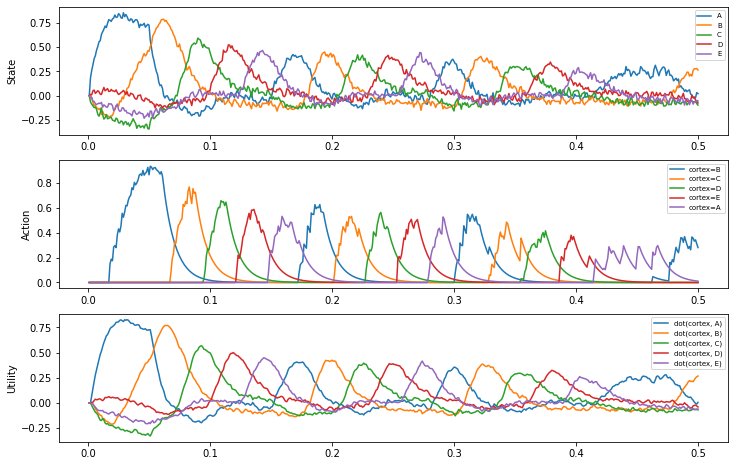
We will use the same ablate_ensemble function as before.
[5]:
def ablate_ensemble(ens, proportion, sim, bias=True):
"""Ablate a proportion of the neurons in an ensemble.
The ablation is done by setting the encoder and gain associated
with a neuron to zero. Since no input current being injected,
the neuron will generally be silent. However, if there is direct
current injected with a neuron-to-neuron connection, then the
cell may still fire. To counter that in most cases, we set the
bias associated with the neuron to a large negative value.
"""
n_neurons = min(int(ens.n_neurons * proportion), ens.n_neurons)
idx = np.random.choice(np.arange(ens.n_neurons), replace=False, size=n_neurons)
encoder_sig = sim.signals[sim.model.sig[ens]["encoders"]]
encoder_sig.setflags(write=True)
encoder_sig[idx] = 0.0
encoder_sig.setflags(write=False)
if bias:
bias_sig = sim.signals[sim.model.sig[ens.neurons]["bias"]]
bias_sig.setflags(write=True)
bias_sig[idx] = -1000
This time, however, instead of applying it to a single ensemble, we will apply it to all of the ensembles in a SPA module.
We can therefore see the effects of ablation in different parts of the model. Let’s see what happens when ablating 25% of the neurons in the cortex.
[6]:
with nengo.Simulator(model) as sim:
for ens in model.cortex.all_ensembles:
ablate_ensemble(ens, 0.25, sim)
sim.run(0.5)
plot()
/home/tbekolay/Code/nengo/nengo/builder/builder.py:234: UserWarning: Object <BasalGanglia "bg"> has already been built.
warnings.warn(f"Object {obj} has already been built.")
/home/tbekolay/Code/nengo/nengo/builder/builder.py:234: UserWarning: Object <Thalamus "thal"> has already been built.
warnings.warn(f"Object {obj} has already been built.")
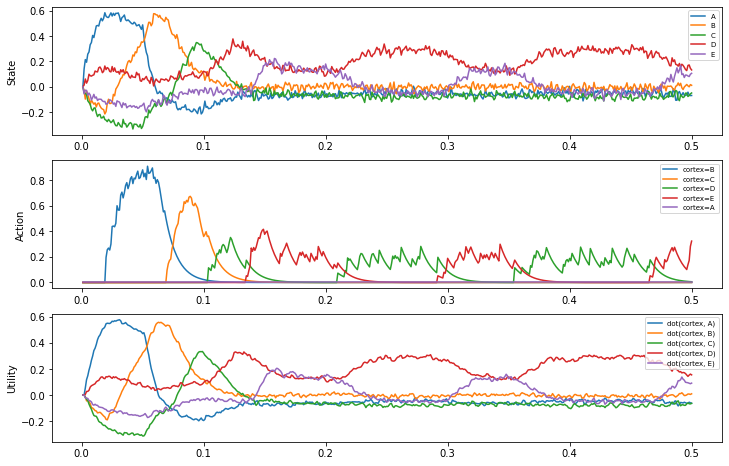
In some cases, the sequence stops after some time, which is interesting!
It saves us a tiny bit of typing to make a helper function to ablate whole networks (or SPA modules). So let’s do that, then look at the effects of ablating the other parts of the model.
[7]:
def ablate_network(net, proportion, sim, bias=True):
"""Ablate a proportion of the neurons in all ensembles in a network."""
for ens in net.all_ensembles:
ablate_ensemble(ens, proportion, sim, bias=bias)
[8]:
with nengo.Simulator(model) as sim:
ablate_network(model.bg, 0.25, sim)
sim.run(0.5)
plot()
/home/tbekolay/Code/nengo/nengo/builder/builder.py:234: UserWarning: Object <BasalGanglia "bg"> has already been built.
warnings.warn(f"Object {obj} has already been built.")
/home/tbekolay/Code/nengo/nengo/builder/builder.py:234: UserWarning: Object <Thalamus "thal"> has already been built.
warnings.warn(f"Object {obj} has already been built.")
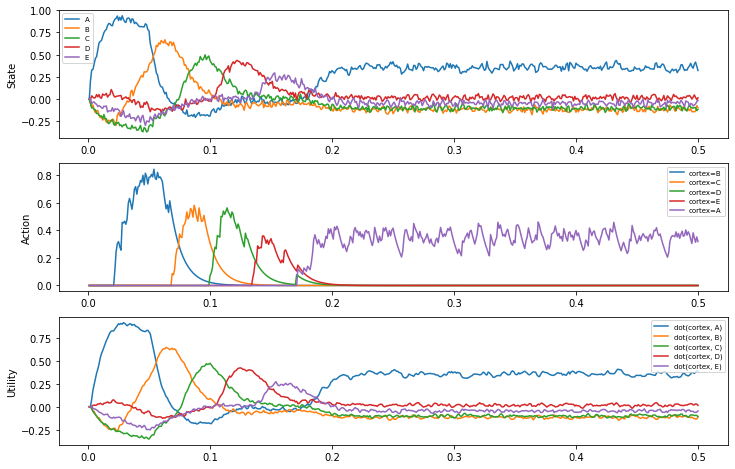
[9]:
with nengo.Simulator(model) as sim:
ablate_network(model.thal, 0.25, sim)
sim.run(0.5)
plot()
/home/tbekolay/Code/nengo/nengo/builder/builder.py:234: UserWarning: Object <BasalGanglia "bg"> has already been built.
warnings.warn(f"Object {obj} has already been built.")
/home/tbekolay/Code/nengo/nengo/builder/builder.py:234: UserWarning: Object <Thalamus "thal"> has already been built.
warnings.warn(f"Object {obj} has already been built.")
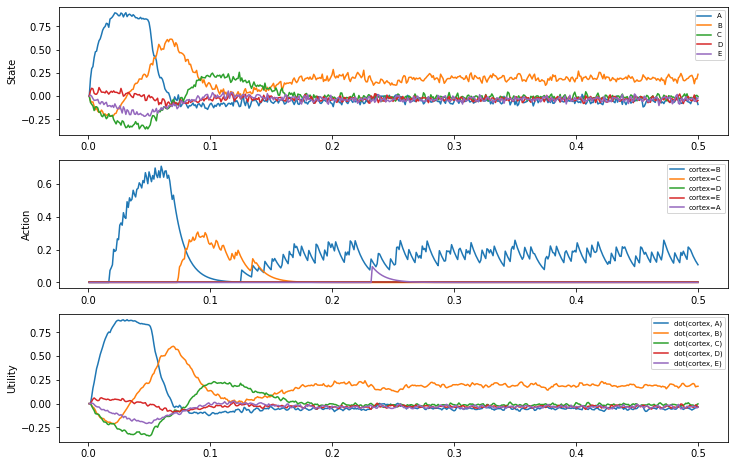
Finally, let’s look at what happens when we ablate 25% of the neurons in the entire model.
[10]:
with nengo.Simulator(model) as sim:
ablate_network(model, 0.25, sim)
sim.run(0.5)
plot()
/home/tbekolay/Code/nengo/nengo/builder/builder.py:234: UserWarning: Object <BasalGanglia "bg"> has already been built.
warnings.warn(f"Object {obj} has already been built.")
/home/tbekolay/Code/nengo/nengo/builder/builder.py:234: UserWarning: Object <Thalamus "thal"> has already been built.
warnings.warn(f"Object {obj} has already been built.")
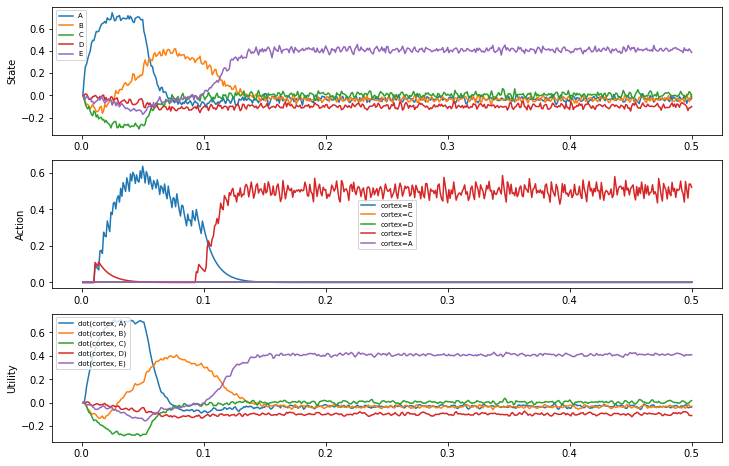
Not silencing the neurons seems to hurt performance, possibly due to the added noise of the random spikes.
[11]:
with nengo.Simulator(model) as sim:
ablate_network(model, 0.25, sim, bias=False)
sim.run(0.5)
plot()
/home/tbekolay/Code/nengo/nengo/builder/builder.py:234: UserWarning: Object <BasalGanglia "bg"> has already been built.
warnings.warn(f"Object {obj} has already been built.")
/home/tbekolay/Code/nengo/nengo/builder/builder.py:234: UserWarning: Object <Thalamus "thal"> has already been built.
warnings.warn(f"Object {obj} has already been built.")
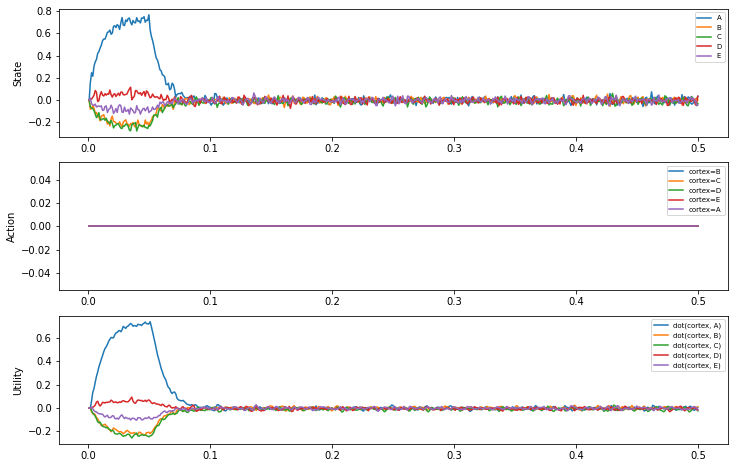
To verify that this is indeed working as expected, we can ablate all of the neurons and confirm that there is no activity in the model.
[12]:
with nengo.Simulator(model) as sim:
ablate_network(model, 1, sim)
sim.run(0.5)
plot()
/home/tbekolay/Code/nengo/nengo/builder/builder.py:234: UserWarning: Object <BasalGanglia "bg"> has already been built.
warnings.warn(f"Object {obj} has already been built.")
/home/tbekolay/Code/nengo/nengo/builder/builder.py:234: UserWarning: Object <Thalamus "thal"> has already been built.
warnings.warn(f"Object {obj} has already been built.")
